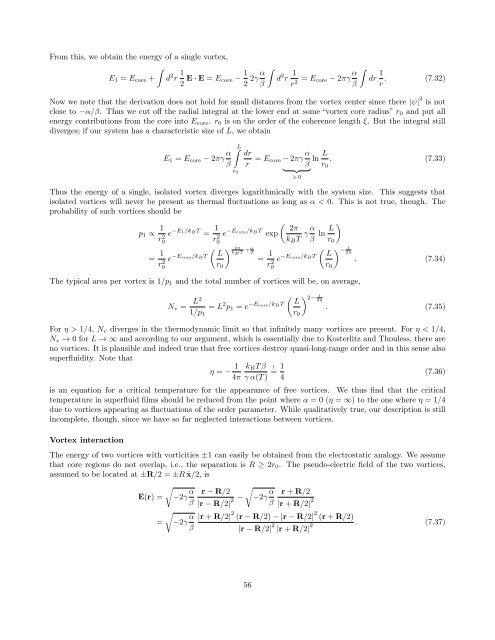Carsten Timm: Theory of superconductivity
Carsten Timm: Theory of superconductivity
Carsten Timm: Theory of superconductivity
You also want an ePaper? Increase the reach of your titles
YUMPU automatically turns print PDFs into web optimized ePapers that Google loves.
From this, we obtain the energy <strong>of</strong> a single vortex,<br />
∫<br />
E 1 = E core + d 2 r 1 2 E · E = E core − 1 2 2γ α ∫<br />
β<br />
d 2 r 1 r 2 = E core − 2πγ α β<br />
∫<br />
dr 1 r . (7.32)<br />
Now we note that the derivation does not hold for small distances from the vortex center since there |ψ| 2 is not<br />
close to −α/β. Thus we cut <strong>of</strong>f the radial integral at the lower end at some “vortex core radius” r 0 and put all<br />
energy contributions from the core into E core . r 0 is on the order <strong>of</strong> the coherence length ξ. But the integral still<br />
diverges; if our system has a characteristic size <strong>of</strong> L, we obtain<br />
E 1 = E core − 2πγ α β<br />
∫ L<br />
r 0<br />
dr<br />
r = E core − 2πγ α ln L . (7.33)<br />
β r<br />
} {{ } 0<br />
> 0<br />
Thus the energy <strong>of</strong> a single, isolated vortex diverges logarithmically with the system size. This suggests that<br />
isolated vortices will never be present as thermal fluctuations as long as α < 0. This is not true, though. The<br />
probability <strong>of</strong> such vortices should be<br />
( 2π<br />
e −Ecore/kBT exp<br />
k B T γ α β ln L )<br />
r 0<br />
p 1 ∝ 1 r0<br />
2 e −E1/kBT = 1 r0<br />
2<br />
= 1 r 2 0<br />
e −E core/k B T<br />
( ) 2π<br />
L<br />
k B T γ α β<br />
1 =<br />
r 0 r0<br />
2 e −E core/k B T<br />
The typical area per vortex is 1/p 1 and the total number <strong>of</strong> vortices will be, on average,<br />
N v =<br />
( L<br />
r 0<br />
) − 1<br />
2η<br />
. (7.34)<br />
( ) 2− 1<br />
L2<br />
= L 2 p 1 = e −Ecore/k BT L<br />
2η<br />
. (7.35)<br />
1/p 1 r 0<br />
For η > 1/4, N v diverges in the thermodynamic limit so that infinitely many vortices are present. For η < 1/4,<br />
N v → 0 for L → ∞ and according to our argument, which is essentially due to Kosterlitz and Thouless, there are<br />
no vortices. It is plausible and indeed true that free vortices destroy quasi-long-range order and in this sense also<br />
superfluidity. Note that<br />
η = − 1<br />
4π<br />
k B T β<br />
γ α(T )<br />
!<br />
= 1 4<br />
(7.36)<br />
is an equation for a critical temperature for the appearance <strong>of</strong> free vortices. We thus find that the critical<br />
temperature in superfluid films should be reduced from the point where α = 0 (η = ∞) to the one where η = 1/4<br />
due to vortices appearing as fluctuations <strong>of</strong> the order parameter. While qualitatively true, our description is still<br />
incomplete, though, since we have so far neglected interactions between vortices.<br />
Vortex interaction<br />
The energy <strong>of</strong> two vortices with vorticities ±1 can easily be obtained from the electrostatic analogy. We assume<br />
that core regions do not overlap, i.e., the separation is R ≥ 2r 0 . The pseudo-electric field <strong>of</strong> the two vortices,<br />
assumed to be located at ±R/2 = ±R ˆx/2, is<br />
E(r) =<br />
=<br />
√<br />
−2γ α β<br />
√<br />
−2γ α β<br />
r − R/2<br />
√−2γ<br />
|r − R/2| 2 − α β<br />
r + R/2<br />
|r + R/2| 2<br />
|r + R/2| 2 (r − R/2) − |r − R/2| 2 (r + R/2)<br />
|r − R/2| 2 |r + R/2| 2 . (7.37)<br />
56

















